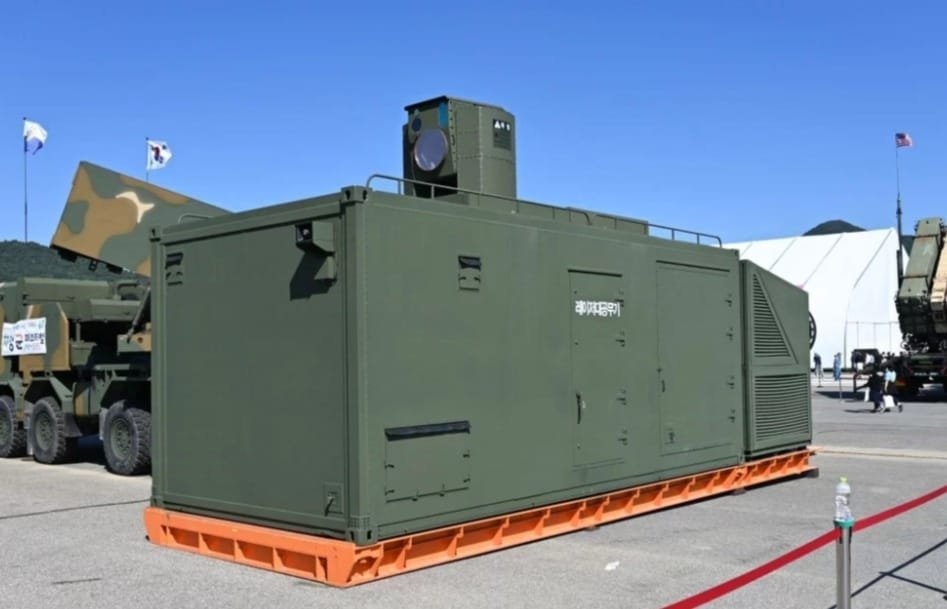
South Korea Commissions Cheongwang Its Most Modern Laser System to Counter Aerial Threats
The Republic of Korea Armed Forces has marked a significant advancement in air defense capabilities with the official announcement of the commissioning of the ‘Cheongwang’ (Sky Light) high-energy laser (HEL) system for military use, which was officially integrated into active service on October 4 during the KADEX 2024 exhibition in South Korea.
Developed as a state-of-the-art anti-aircraft solution, the ‘Cheongwang’ system uses high-energy lasers to intercept a variety of aerial targets, including drones, missiles, and potentially other airborne threats. By employing directed energy rather than conventional munitions, the system offers a rapid, precise, and cost-effective means of neutralizing targets. With the increasing prevalence of unmanned systems and low-cost drones in global military engagements, the integration of such systems is becoming essential for maintaining robust air defenses.
Hanwha Aerospace, South Korea’s leading defense and aerospace company, played a pivotal role in the unveiling and presentation of this system. Alongside the ‘Cheongwang,’ Hanwha Aerospace introduced an array of mobile and fixed high-energy laser solutions at KADEX 2024. These systems aim to provide adaptable and responsive defense options, aligning with the Republic of Korea Armed Forces’ broader objective to achieve a multi-layered air defense network.
The commissioning of the ‘Cheongwang’ (Sky Light) high-energy laser (HEL) system is critically important for South Korea as it enhances the country’s defense capabilities against emerging threats from North Korea. The HEL system provides a sophisticated means to detect, track, and neutralize aerial threats such as drones, unmanned aerial vehicles (UAVs), and potentially even artillery shells or low-flying missiles. North Korea has been increasingly investing in drone technology and advanced missile systems, which pose significant challenges to South Korea’s security. By deploying the ‘Cheongwang’ system, South Korea can effectively counter these threats with precision and speed, strengthening its defensive posture and deterrence capabilities.
Moreover, the high-energy laser system offers a cost-effective and efficient solution compared to traditional missile defense systems. Laser weapons have a virtually unlimited magazine, as they rely on electricity rather than physical ammunition, allowing for continuous operation against multiple incoming targets. This is particularly important in scenarios where North Korea might employ swarm tactics or saturation attacks to overwhelm conventional defenses. The ‘Cheongwang’ system’s ability to engage numerous threats rapidly reduces the risk of successful attacks on South Korean territory and minimizes potential damage and casualties. In essence, the deployment of the HEL system is a strategic move to address the evolving nature of threats from North Korea, ensuring that South Korea remains resilient and prepared in the face of regional security challenges.
The development of the ‘Cheongwang’ (Sky Light) high-energy laser (HEL) system began as part of South Korea’s efforts to bolster its defense capabilities against evolving aerial threats. Initiated in the early 2020s by the Agency for Defense Development (ADD), the project aimed to create an advanced laser weapon system capable of detecting, tracking, and neutralizing low-altitude aerial targets such as drones and unmanned aerial vehicles (UAVs). The Cheongwang HEL system represents a significant technological advancement in South Korea’s defense arsenal, addressing the need for rapid and effective responses to modern warfare challenges posed by adversaries like North Korea.
In terms of operational capability, the ‘Cheongwang’ high-energy laser is engineered for both precision and efficiency. Utilizing high-frequency laser beams, it delivers a rapid response against fast-moving threats with minimal collateral impact. The decision to opt for laser technology enables the system to operate effectively even in urban or high-density areas, where traditional interception methods might pose additional risks.
The Block-I Cheongwang is a container-sized, land-based laser weapon system developed by South Korea’s Defense Acquisition Program Administration (DAPA) since 2019, with a budget of $63 million. Measuring 9 meters long, 3 meters wide, and 3 meters high (29.5 x 9.8 x 9.8 feet), it utilizes a 20 kW optical fiber laser capable of generating approximately 700°C heat during 10-20 second impulses. The system has an effective range of up to 3 kilometers and includes an integrated radar mast for target detection and tracking. Designed to counter small to mid-sized drones, multicopters, and UAVs, it operates silently and invisibly, requiring only electricity without the need for separate ammunition. Each shot costs about $1.45 (2,000 Won), making it a cost-effective solution for air defense. Deployment is scheduled to begin in 2024, with future versions potentially capable of neutralizing larger targets like aircraft and ballistic missiles.
The ‘Cheongwang’ (Sky Light) high-energy laser (HEL) system is a cutting-edge defense technology commissioned by South Korea to enhance its capability against aerial threats, particularly drones and unmanned aerial vehicles (UAVs). Unlike traditional weapons, it does not utilize a conventional warhead; instead, it employs a powerful laser beam as its means of interception. The laser’s high-energy output allows it to effectively disable or destroy the electronic components of incoming targets, neutralizing them without the need for explosive force. This directed-energy approach provides a rapid response to threats and reduces the risk of collateral damage.
In terms of range and guidance, the Cheongwang HEL system is equipped with advanced sensors and tracking systems that detect and monitor aerial targets at significant distances. While specific range details are classified, high-energy laser systems typically engage targets within several kilometers. The system uses precise targeting algorithms to focus the laser beam on critical parts of the threat, such as guidance systems or propulsion units. The guidance system continuously adjusts for target movement and atmospheric conditions, ensuring high accuracy and effectiveness. This combination of advanced detection, tracking, and directed-energy interception makes the Cheongwang HEL a vital asset in countering modern aerial threats posed by adversaries like North Korea.

